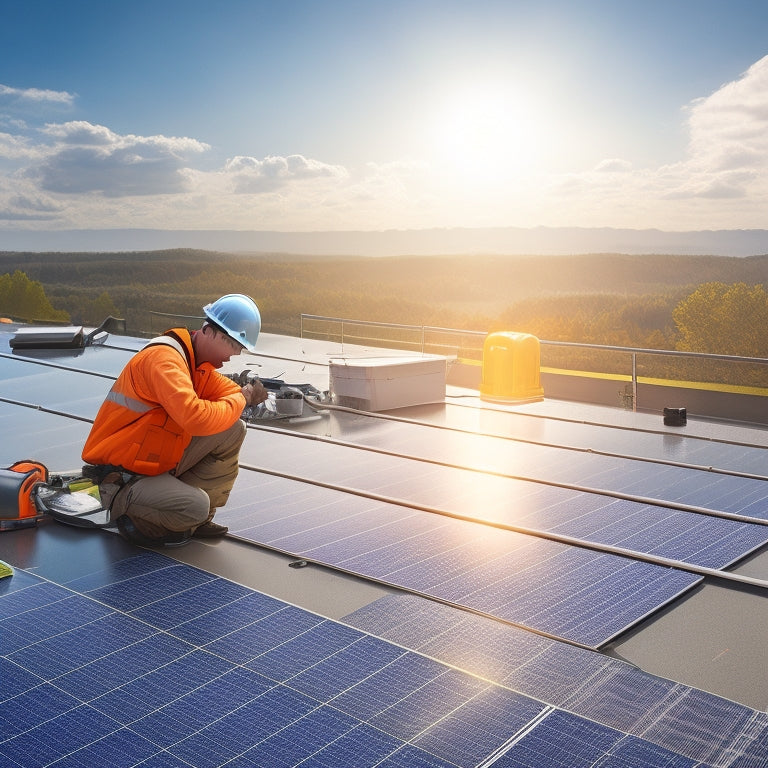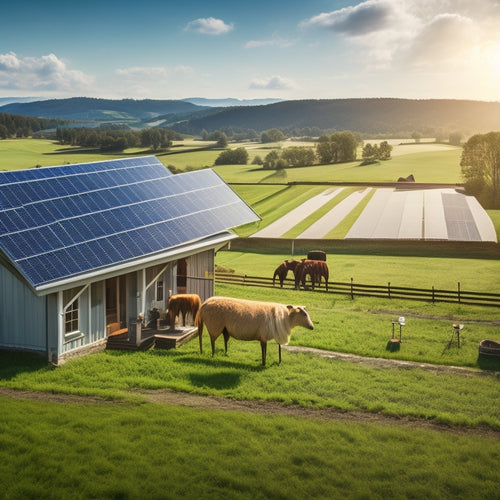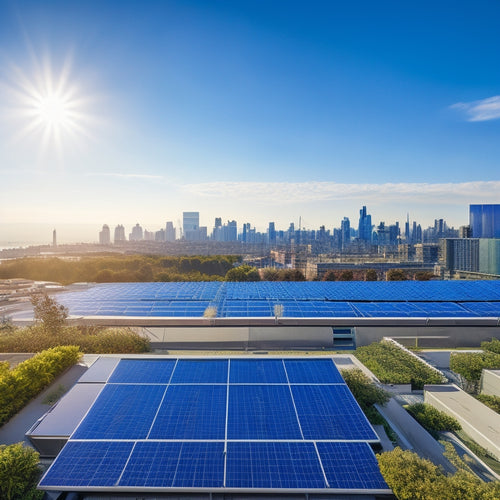
A 7-Step Approach to Installing Solar System Panels
Share
You're about to commence on an adventure to utilize the power of the sun, and the first step is to understand that the average American household consumes around 30 kWh of energy daily, making it crucial to evaluate your energy needs accurately to design an efficient solar system that meets your specific requirements. Next, you'll need to select the right equipment, considering factors like panel type and inverter compatibility, before preparing your installation site by removing obstacles and confirming rooftop readiness. Then, install the mounting system, followed by connecting your solar panels, and finally, you'll be ready to optimize your system's performance - but there's more to investigate to guarantee a seamless installation.
Key Takeaways
- Assess energy needs by calculating daily energy consumption and identifying peak sun hour ratings to design an efficient solar system.
- Choose the right equipment, including solar panel type and inverter, ensuring compatibility with energy requirements and local building codes.
- Prepare the installation site by conducting a site assessment, removing debris, and inspecting the roof for damage or weakness.
- Install a secure mounting system, including roof anchors, racking, and clamps, following manufacturer's instructions and local regulations.
- Connect solar panels, verifying secure fastening, optimal orientation, and proper electrical connections, grounding, and weatherproofing.
Assess Your Energy Needs
About 30 kilowatt-hours (kWh) of electricity per day is the average energy consumption of a typical American household. To determine your energy needs, you'll need to calculate your daily energy consumption.
Start by identifying the appliances and devices you want to power with your solar system. Make a list of each item, including its wattage and the number of hours you use it daily. Multiply the wattage by the hours used to get the total daily energy consumption in watt-hours (Wh). Then, divide the total Wh by 1,000 to convert it to kWh.
Your energy consumption pattern will also impact your system's efficiency. If you use most of your energy during the day, a solar system with a high peak sun hour rating will be more efficient. Conversely, if you use most of your energy at night, you may need a system with a larger battery bank to store excess energy generated during the day.
Understanding your energy needs will help you design a solar system that meets your requirements, ensuring ideal system efficiency and reducing your reliance on the grid.
Choose the Right Equipment
Now that you've calculated your daily energy consumption, you can focus on selecting the right equipment for your solar system. This involves choosing the suitable solar panel types and inverter selection to guarantee peak energy production.
When it comes to solar panel types, you'll need to decide between monocrystalline, polycrystalline, or thin-film panels. Monocrystalline panels offer high efficiency but are more expensive. Polycrystalline panels are more affordable but have slightly lower efficiency. Thin-film panels are the most budget-friendly option but have the lowest efficiency.
Consider factors like budget, available space, and desired energy output when making your decision.
Inverter selection is critical as it converts DC power from the solar panels to AC power for your home. You'll need to choose between a string inverter, microinverter, or power optimizer. String inverters are the most common, but microinverters and power optimizers offer more flexibility and monitoring capabilities.
Confirm the inverter you select is compatible with your solar panel type and meets your energy requirements. By selecting the right equipment, you'll be able to maximize your solar system's energy production and achieve your desired level of energy independence.
Prepare the Installation Site
Your rooftop is the foundation of your solar system, and preparing it for installation is crucial for a successful and efficient energy harvest.
Before you start installing your solar panels, you need to verify your rooftop is ready for them. This involves conducting a thorough site assessment to identify any potential obstacles or limitations.
Some key considerations for preparing your installation site include:
-
Removing any debris, vegetation, or obstructions that could interfere with the installation or operation of your solar panels
-
Inspecting your roof for any signs of damage, wear, or weakness that could affect the structural integrity of your solar system
-
Identifying the ideal orientation and angle for your solar panels to maximize energy production
-
Confirming compliance with local building codes and regulations
-
Conducting space optimization to determine the most efficient layout for your solar panels and maximize energy production
Install the Mounting System
Three main components make up a solar panel mounting system: the roof anchors, the racking system, and the clamps.
You'll need to install these components correctly to guarantee a secure and efficient solar panel system. Start by identifying the ideal mounting location on your roof, considering factors like roof orientation, structural integrity, and local building codes.
Next, use specialized installation tools to secure the roof anchors, which will provide a solid foundation for the racking system. The racking system, comprising rails and brackets, will then be attached to the anchors, providing a structure for the solar panels.
Finally, you'll secure the panels to the racking system using clamps, employing precise mounting techniques to minimize shading and maximize energy output.
It's vital to follow the manufacturer's instructions and local regulations when installing the mounting system, as improper installation can compromise the entire solar panel system.
Connect the Solar Panels
The solar panel array, comprising multiple panels connected in series and parallel, is the heart of your solar power system. You'll connect the panels according to the manufacturer's instructions and your system design. Confirm the panels are securely fastened to the mounting system, and the electrical connections are made with proper wiring techniques.
When connecting the panels, consider the following key factors:
-
Panel orientation: Verify the panels are installed at the ideal angle and direction to maximize energy production.
-
Wiring techniques: Use the recommended wiring techniques to minimize energy losses and guarantee safe operation.
-
Series and parallel connections: Understand how to connect panels in series and parallel to achieve the desired voltage and current output.
-
Grounding and bonding: Make sure all metal components are properly grounded and bonded to prevent electrical shock and fire hazards.
-
Weatherproofing: Seal all electrical connections and wiring to prevent water ingress and corrosion.
Frequently Asked Questions
Can I Install Solar Panels on a Metal or Asphalt Shingle Roof?
When considering solar panel installation, you'll need to assess roof compatibility; metal roofs are generally suitable, but asphalt shingle roofs require additional installation considerations, such as waterproofing and structural integrity, to guarantee a secure and efficient energy-harvesting system.
How Often Should I Clean My Solar Panels for Optimal Performance?
Your solar panels are like a car's windshield, needing regular cleaning to maintain clarity; for peak performance, you should clean them every 6-12 months, depending on environmental factors, as part of routine solar panel maintenance to guarantee maximum energy utilization.
Are Solar Panels Resistant to Hail and Extreme Weather Conditions?
You'll be relieved to know that solar panels are designed to withstand extreme weather conditions, including hail, with most manufacturers testing their products to guarantee hail resistance up to 25mm in diameter at 23m/s.
Can I Expand My Solar Panel System in the Future if Needed?
You can easily expand your solar panel system in the future if needed, as long as you guarantee system compatibility and plan for future capacity, allowing you to seamlessly add more panels or upgrade your inverter.
Do Solar Panels Void My Roof's Warranty or Affect Its Integrity?
When you install solar panels, like in the case of California's San Mateo County, where 80% of homes have solar, you won't typically void your roof's warranty, but guarantee the installation maintains your roof's integrity, as improper mounting can compromise its structure.
Conclusion
You've successfully installed your solar system panels! Now, you're utilizing the power of the sun to reduce your energy bills and carbon footprint. According to the International Energy Agency, solar energy could become the largest source of electricity globally by mid-century, with solar PV capacity reaching 14,000 gigawatts. As you enjoy the benefits of renewable energy, remember to monitor and maintain your system to guarantee peak performance. Congratulations on taking a significant step towards a sustainable future!
Related Posts
-

Innovative Sustainable Materials for Energy-Efficient Homes
Innovative sustainable materials enable you to create energy-efficient homes while promoting environmental responsibi...
-

Solar Power Systems for Rural Properties
Solar power systems offer a reliable and efficient energy solution for rural properties, allowing you to gain energy ...
-

Business Solar Investments for Cost-Effective Sustainability
Investing in solar energy is a smart move for your business, providing a solid foundation for cost-effective sustaina...


